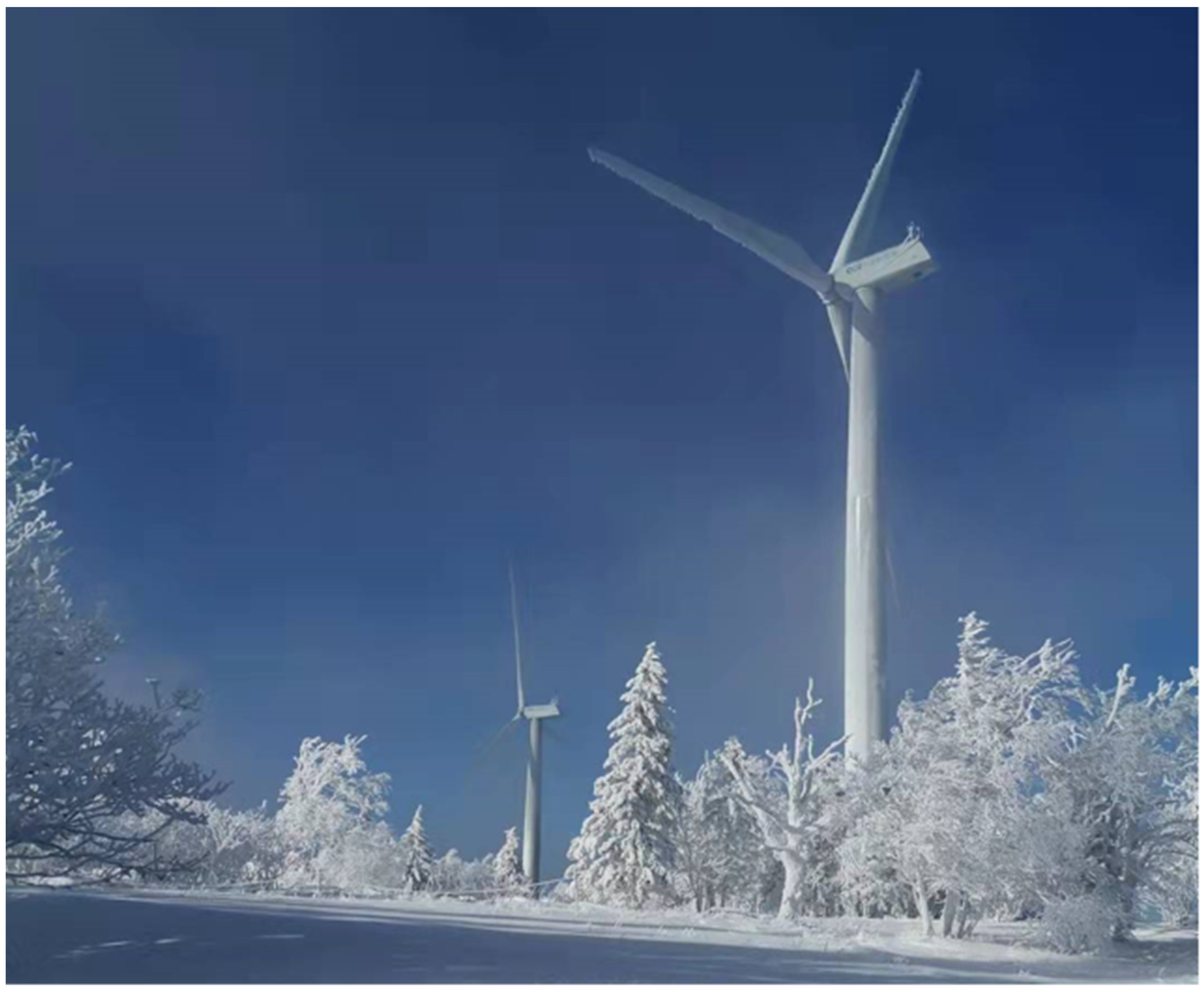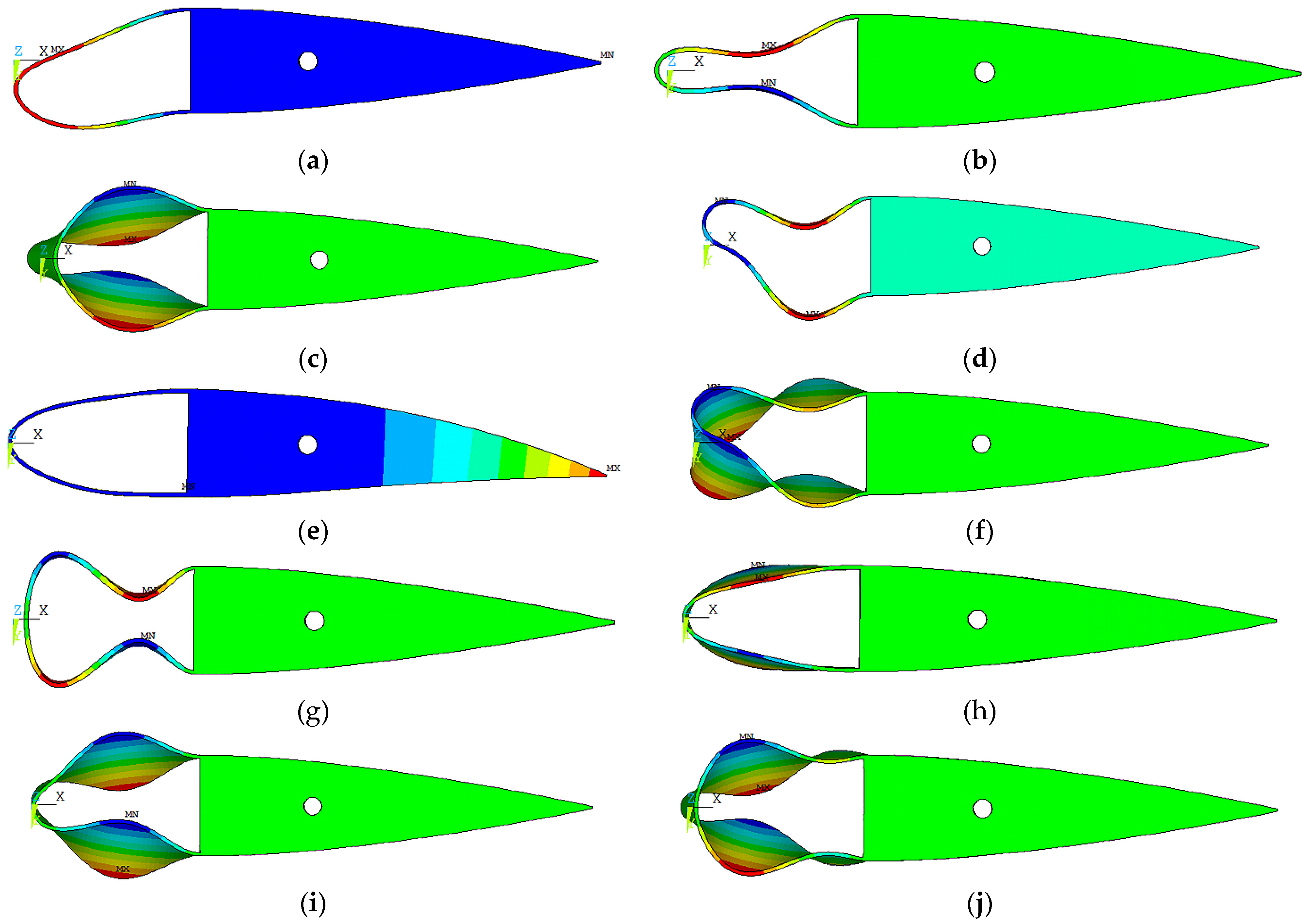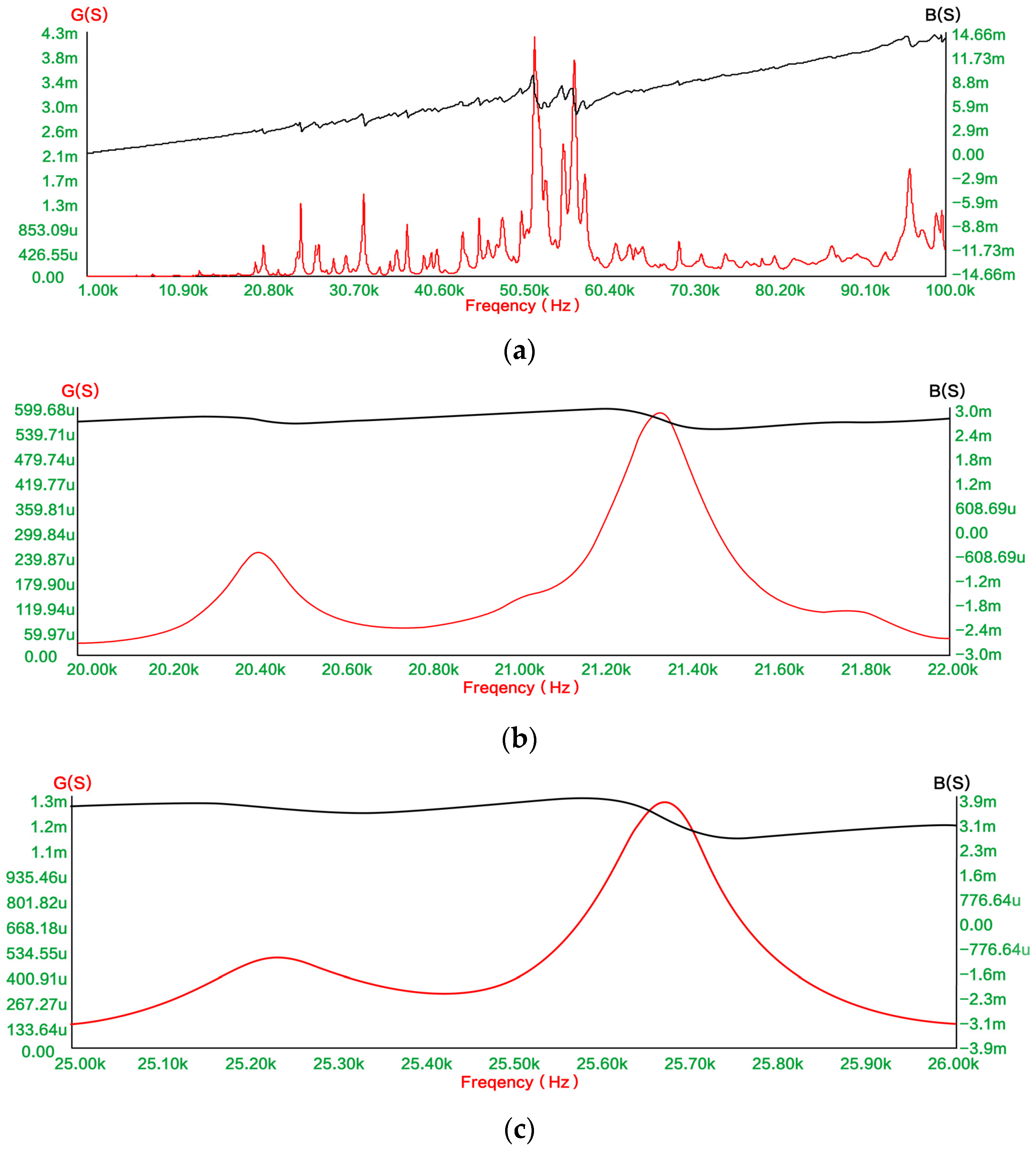Simulation and Experimental Study on the Ultrasonic Micro-Vibration De-Icing Method for Wind Turbine Blades
Abstract
:1. Introduction
2. Simulation
2.1. Simulation Model of the Blade
2.2. Simulation of the De-Icing Vibration Mode
3. De-Icing Experiment
3.1. Blade Sample
3.2. Experimental System
3.2.1. Design of the Reflux Tunnel
3.2.2. Design of the Cooling System
3.2.3. Design of the Spray System
3.3. Measurement of the Natural Frequency
- (1)
- The differences in the size and the material properties between the blade model and the blade sample. For the blade sample, the material property is not completely the same as the one in the simulation, such as the density, the Yang’s Elastic Modulus and the Poisson’s ratio. In addition, the manufacturing error also led to the size discrepancy between the model and the sample;
- (2)
- The differences in the size, the material properties and the assembly method between the PZT patch model and the PZT patch sample. The material properties of the PZT patch sample are different from the one in the simulation model, such as the permittivity, the density, the piezoelectric constant, the stiffness matrix, and so on. In addition, the PZT patch samples also have discrepancies with each other because of the error of the processing technique. With regards to the PZT assembly, the PZT patches were pasted on the inner surface of the leading edge with epoxy resin. There was a glue sheet between the PZT patch and the blade. However, in the process of the simulation, the PZT patches should ideally be connected with the blade by the VGLUE command. Therefore, there was a discrepancy between the simulation model and the sample.
3.4. Experimental Scheme
3.5. Experimental Results
4. Conclusions
- (1)
- An airfoil blade segment with a hollow structure was designed, and the model analysis of it was calculated. The bending vibration mode, in which the vibration amplitude alternates positively and negatively, was selected as the de-icing vibration mode;
- (2)
- A return-flow icing wind tunnel was built, and a device for measuring the adhesive strength of the ice covering the blade surface was designed and manufactured. Three natural frequencies of the blade segment, 21,228 Hz, 25,604 Hz and 27,254 Hz, were measured and selected as the experimental frequencies for the ultrasonic de-icing test;
- (3)
- The adhesive shear stresses of the ices under the different frequencies were measured and calculated. The adhesive shear stress of the ice, generated under the dynamic flow field condition, was lower than the glaze ice, generated by the freezing of the water under the static air condition. Under the ultrasonic vibration condition, the adhesive shear stress decreased. When the frequency was 21.228 kHz, the adhesive shear stress was lowest, which was approximately 0.084 MPa.
5. Future Work
Author Contributions
Funding
Institutional Review Board Statement
Informed Consent Statement
Data Availability Statement
Conflicts of Interest
References
- De La Puente-Gil, Á.; González-Martínez, A.; Borge-Diez, D.; Martínez-Cabero, M.-Á.; De Simón-Martín, M. True power consumption labeling and mapping of the health system of the Castilla y León region in Spain by clustering techniques. Energy Procedia 2019, 157, 1164–1181. [Google Scholar] [CrossRef]
- Lee, B.B. Wind Turbine Repowering Is on the Horizon. 2016. Available online: https://www.powermag.com/wind-turbine-repowering-horizon (accessed on 30 November 2021).
- Himpler, S.; Madlener, R. Repowering of Wind Turbines: Economics and Optimal Timing. SSRN 2012, 7, 1–10. [Google Scholar] [CrossRef]
- Rio, P.D.; Silvosa, A.C.; Gomez, G.I. Policies and design elements for the repowering of wind farms: A qualitative analysis of different options. Energy Policy 2011, 39, 1897–1908. [Google Scholar]
- Dalili, N.; Edrisy, A.; Cansdale, R. A review of surface engineering issues critical to wind turbine performance. Renew. Sust. Energy Rev. 2009, 13, 428–438. [Google Scholar] [CrossRef]
- Lehtomäki, V.; Krenn, A.; Ordaens, P.J.; Godreau, C. IEA Wind TCP Task 19: Available Technologies for Wind Energy in Cold Climate; IEA Wind: Roskilde, Denmark, 2018. [Google Scholar]
- Gao, L.; Tao, T.; Liu, Y.; Hu, H. A field study of ice accretion and its effects on the power production of utility-scale wind turbines. Renew. Energy 2020, 167, 917–928. [Google Scholar] [CrossRef]
- Tan, H.H.; Li, L.P.; Zhu, Y.J. The finite element analysis on the influence of icing on the dynamic performance of the wind turbine. Renew. Energy Resour. 2018, 28, 33–38. (In Chinese) [Google Scholar]
- Guo, W.F.; Shen, H.; Li, Y. Wind tunnel tests of the rime icing characteristics of a straight-bladed vertical axis wind turbine. Renew. Energy 2021, 179, 116–132. [Google Scholar] [CrossRef]
- Guo, W.F.; Zhang, Y.W.; Li, Y. A Wind Tunnel Experimental Study on the Icing Characteristics of a Cylinder Rotating around a Vertical Axis. Appl. Sci. 2021, 11, 10383. [Google Scholar] [CrossRef]
- Yi, X.; Wang, K.C.; Ma, H.L. Computation of icing and its effct of horizontal axis wind turbine. Acta Energ. Sol. Sin. 2014, 35, 1052–1058. (In Chinese) [Google Scholar]
- Qian, M.S. Research on Electro-thermal Deicing System Based on Graphene Heating Film. Master’s Thesis, Nanjing University of Aeronautics and Astronautics, Nanjing, China, 2018. (In Chinese). [Google Scholar]
- Cao, L.; Jones, A.K.; Sikka, V.K. Anti-Icing Superhydrophobic Coatings. Langmuir 2009, 25, 12444–12448. [Google Scholar] [CrossRef]
- Textron, B.H., Jr. Helicopter Rotor Icing Protection Methods. J. Am. Helicopter Soc. 1985, 32, 34–39. [Google Scholar]
- Martin, C.A.; Putt, J.C. Advanced pneumatic impulse ice protection system (PIIP) for aircraft. J. Aircr. 2015, 29, 714–716. [Google Scholar] [CrossRef]
- Jose, L.P.; Edward, C.S. Ultrasonic shear wave anti-icing system for helicopter rotor blades. In Proceedings of the American Helicopter Society 62nd Annual Forum, Phoenix, AZ, USA, 9–11 May 2006. [Google Scholar]
- Jose, L.P.; Edward, C.S.; Joseph, L.R. Investigation of an ultrasonic ice protection system for helicopter rotor blades. In Proceedings of the American Helicopter Society 64th Annual Forum, Montréal, QC, Canada, 29 April–1 May 2008. [Google Scholar]
- Palacios, J.L.; Yun, Z.; Smith, E.C. Ultrasonic shear and lamb wave interface stress for helicopter rotor de-icing purposes. In Proceedings of the 47th AIAA/ASME/ASCE/AHS/ASC Structures, Structural Dynamics, and Materials Conference, Newport, RI, USA, 1–4 May 2006. [Google Scholar]
- Shi, Z.; Zhao, Y.; Ma, C.; Zhang, J. Parametric Study of Ultrasonic De-Icing Method on a Plate with Coating. Coatings 2020, 10, 631. [Google Scholar] [CrossRef]
- Palacios, J.; Smith, E.; Rose, J. Instantaneous De-Icing of Freezer Ice via Ultrasonic Actuation. AIAA J. 2011, 49, 1158–1167. [Google Scholar] [CrossRef] [Green Version]
- Guo, W.F.; Dong, X.Y.; Li, Y. Simulations on vibration mode and distribution of shear stress for icing aluminum plate excited by ultrasonic vibration. Adv. Mech. Eng. 2020, 12, 1–9. [Google Scholar] [CrossRef]
- Tan, H.H.; Li, L.P.; Panke, J. Ultrasonic de-icing theory and method for wind turbine blades. Proc. CSEE 2010, 30, 112–117. (In Chinese) [Google Scholar]
- Yan, J.; Li, L.P.; Lei, L.B. Experimental research on ultrasonic de-icing for wind turbine blades and its application. Renew. Energy Resour. 2015, 33, 68–74. (In Chinese) [Google Scholar]
- Wang, Y.; Xu, Y.; Su, F. Damage accumulation model of ice detach behavior in ultrasonic de-icing technology. Renew. Energy 2020, 153, 1396–1405. [Google Scholar] [CrossRef]
- Palacios, J.; Smith, E.; Rose, J. Ultrasonic De-Icing of Wind-Tunnel Impact Icing. J. Aircr. 2011, 48, 1020–1027. [Google Scholar] [CrossRef]
- Li, H.; Deng, J.; Zhang, S.; Yu, H.; Liu, Y. Design and Experiment of a Three-Feet Linear Ultrasonic Motor Using Third Bending Hybrid Modes. Sens. Actuator A Phys. 2021, 331, 112990. [Google Scholar] [CrossRef]
- Izuhara, S.; Mashimo, T. Design and characterization of a thin linear ultrasonic motor for miniature focus systems. Sens. Actuator A Phys. 2021, 329, 112797. [Google Scholar] [CrossRef]
- Habibi, H.; Cheng, L.; Zheng, H.; Kappatos, V.; Selcuk, C.; Gan, T.-H. A dual de-icing system for wind turbine blades combining high-power ultrasonic guided waves and low-frequency forced vibrations. Renew. Energy 2015, 83, 859–870. [Google Scholar] [CrossRef] [Green Version]
- Jing, Z.; Song, B. Research on experiment and numerical simulation of ultrasonic de-icing for wind turbine blades. Renew. Energy 2017, 113, 706–712. [Google Scholar]
- Tabor, L.E.R. The Adhesion and Strength Properties of Ice. Proc. R. Soc. Lond. Ser. A Math. Phys. Eng. Sci. 1958, 245, 184–201. [Google Scholar]














| Working Parameters | Values |
|---|---|
| Cross-section of the test section | 250 × 250 mm2 |
| Temperature | 0 °C~−20 °C |
| Wind speed | 0~20 m/s |
| Diameter of the water droplet | 50 μm |
| Simulation Results | Measurement Results |
|---|---|
| 21,935.6 Hz | 21,228 Hz |
| 25,094 Hz | 25,604 Hz |
| 27,896.9 Hz | 27,254 Hz |
| 21,935.6 Hz | 21,228 Hz |
| Experimental Conditions | Values |
|---|---|
| Experimental temperature | −12 °C |
| Wind speed | 5 m/s |
| Excitation frequency | 21,228 Hz, 25,604 Hz, 27,254 Hz |
| Excitation voltage Vp--p | 400V |
| Angle of attack | 0° |
| Excitation Frequency (Hz) | Mean Value of Adhesive Shear Stress (MPa) |
|---|---|
| 0 | 0.14 |
| 21,228 | 0.084 |
| 25,604 | 0.089 |
| 27,254 | 0.13 |
Publisher’s Note: MDPI stays neutral with regard to jurisdictional claims in published maps and institutional affiliations. |
© 2021 by the authors. Licensee MDPI, Basel, Switzerland. This article is an open access article distributed under the terms and conditions of the Creative Commons Attribution (CC BY) license (https://creativecommons.org/licenses/by/4.0/).
Share and Cite
Li, Y.; Shen, H.; Guo, W. Simulation and Experimental Study on the Ultrasonic Micro-Vibration De-Icing Method for Wind Turbine Blades. Energies 2021, 14, 8246. https://doi.org/10.3390/en14248246
Li Y, Shen H, Guo W. Simulation and Experimental Study on the Ultrasonic Micro-Vibration De-Icing Method for Wind Turbine Blades. Energies. 2021; 14(24):8246. https://doi.org/10.3390/en14248246
Chicago/Turabian StyleLi, Yan, He Shen, and Wenfeng Guo. 2021. "Simulation and Experimental Study on the Ultrasonic Micro-Vibration De-Icing Method for Wind Turbine Blades" Energies 14, no. 24: 8246. https://doi.org/10.3390/en14248246






